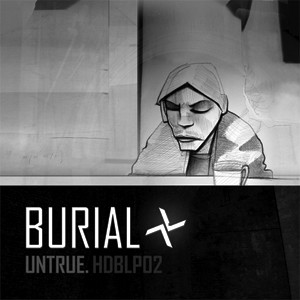Scavenging in the Ghost Town: Hyperdub Comes of Age
The pulsing throb of a simulated heart, the sound of sirens in the distance and then a single chord, echoing through the aural mise-en-abyme: these are musical ingredients familiar to anyone who has paid attention to the independent Hyperdub label’s output over the past five years. But when the first words slur into the mix, like a 33RPM message to a 45RPM world, the special importance of this particular track will immediately become manifest to listeners with the requisite historical knowledge: “This town/Is coming like a ghost town/All the clubs have been closed down.” Dispersed as it may be, Kode9 & The Spaceape’s effort from 2005 is still a cover version of The Specials’ 1981 hit, a fact that does a great deal to illuminate the intentions of label owner Steve Goodman, who recently put out 5: Five Years of Hyperdub to commemorate its achievements thus far.
The original “Ghost Town”, released towards the end of the British ska revival that The Specials helped to spearhead, was a pointed commentary on the social and economic consequences of Margaret Thatcher’s move to dismantle the postwar welfare state. It also fleshed out the consequences of the cross-racial identification – white artists with Afro-Caribbean immigrant culture, black artists with the “white riot” of punk – that had propelled the second coming of ska. Given the Hyperdub treatment by Goodman and Daddie Gee, who have often recorded together under the pen names “Kode9” and “The Spaceape”, “Ghost Town” facilitates a complex political analogy, whereby the panoptic post-9/11 United Kingdom of New Labour’s decline is presented as the logical outcome of Neo-Conservatism’s divisive agenda and investment in the dub aesthetic signals the rejection of its fundamentally racist and classist worldview.
From a musical standpoint, the directness of this comparison helps to make sense of a lot of what happened in the 2000s, from the resurgence of interest in politicized post-punk bands like Gang of Four, Mission of Burma and Scritti Politti to the intense nostalgia for pre-Yamaha DX7 synthesizer tones evident in alternative rock and hip-hop alike. Clearly, the transition from the “Me” Decade to the “Not You” Decade was on a lot of people’s minds during the War on Terror. Looking back to the “clampdown” of the early 1980s clearly must have helped artists come to psychological terms with the increasingly rigid and militaristic social order of their own times.
What sets Hyperdub’s contribution to this trend apart from most of its exponents is the degree to which we can impute political self-awareness to Goodman’s work. While directing his label and his own musical career, he somehow managed to get a Ph.D. in philosophy as well. The fruit of that endeavor, Sonic Warfare: Sound, Affect and the Ecology of Fear, just published by the MIT Press, amply demonstrates that his musical instincts are backed up by the sort of theoretical sophistication that few artists of his stature can muster. And, as a study of the ways in which sound can affect and sometimes even effect politics, it also indicates that the choices he makes in the studio and business office are likely to be driven by his progressive ideology. If he opted to cover “Ghost Town” in 2005, in other words, the decision was motivated by more than his affection for The Specials’ version.
As impressive as this kind of scholarly training may look on a resumé, however, it’s often the case that deep thinking comes at the expense of artistic feeling. What makes Hyperdub’s achievement all the more remarkable, then, is that its releases have never seemed excessively academic. Indeed, Goodman’s own work actually seems less cerebral than that of the most famous artist in his roster, the willfully anonymous Burial. This is not to suggest that the latter’s work suffers for its mind-over-body approach. Burial’s ability to conjure realms that are claustrophobically spacious has been rightfully exalted. As the freelance cultural theorist Mark Fisher, nom de plume “K-Punk”, wrote in a brilliant piece on his first album, “it suggests a city haunted not only by the past but by lost futures. It seems to have less to do with a near future than with the tantalising ache of a future just out of reach.”
Like that 2005 debut and its 2007 follow-up Untrue, the song Burial created expressly for this compilation brilliantly integrates a minimal dub-step rhythm, ambient noises straight out of the movie Alien and soulful vocals AutoTune-warped into something either less – or more – than human. But “Fostercare” comes off differently than its musically similar predecessors because his sound has gone mainstream in the interim. In particular, Kanye West’s 808s & Heartbreak – whose title, incidentally, references the Roland TR-808 synthesizer identified with electronic pop of the early 1980s – borrows from the Burial formula, a debt that the megastar has seemingly acknowledged by featuring “Fostercare” on his website and Facebook page.
For this reason, as well as the attention that Burial has received in the music press, his work now seems more formulaic – if no less aesthetically effective – than that of other Hyperdub artists. This raises the question of whether the music Steve Goodman has released over the past half decade demands a degree of marginality in order to be fully evocative. 5: Five Years of Hyperdub, like most of the label’s releases, conjures an existential mindset in which hope feels like a miracle that must be pieced together from the ruins of other people’s pleasure. But when the scavenger becomes the scavenged, that effect is lost somehow.
This is precisely the dilemma that led to the formation of one of Hyperdub’s newest acts, King Midas Sound. A veteran of the British music scene since the early 1990s. Kevin Martin teamed up with poet Roger Robinson and vocalist Hitomi in an effort to break loose from what he termed the “caricature” that his work as The Bug was in danger of becoming. King Midas Sound’s contribution to the compilation, “Meltdown”, neatly captures the fusion of dub reggae, trip-hop and electronica that made their recent Hyperdub album Waiting For You so compelling. Although not a radical departure from Martin’s previous projects, its passionate delivery breathes warmth onto the chilly fingers of dub-inflected electronica.
Burial’s problem is that, unlike Martin or Goodman, he does not have a public identity outside of the act with which he has until now expressed himself. While a tabloid-fueled push to “out” the man behind the mask, prompted by his being nominated for the prestigious Mercury Prize, finally succeeded in attaching the name “Will Bevan” to him, he has continued to stay as far out of the spotlight as possible. But that retreat may turn out to have been the prelude to both a professional and personal defeat. The state of the music business in 2010 makes it painfully clear that being just one thing can be a major liability in a “post-everything” world, even if that thing starts out almost painfully wonderful.
That’s why, even though the “greatest hits” included on this compilation’s second disc remind us of just how impressive the output of Hyperdub’s formative years could be, it’s the new artists and new approaches on the first disc that make this collection truly rewarding. Flying Lotus doesn’t seem the kind of artist that fits the Hyperdub template at first, but his “Disco Balls” works beautifully here, especially as a prelude to “Fostercare.” The female vocal on Black Chow’s “Purple Smoke” steers the track into pop territory, incongruously recalling the sort of hybrid work at which American independent rock band Enon has excelled.
Most importantly, longtime contributors JOKER, Zomby, Samiyam – not to mention Kode9 himself – all offer tracks that wriggle free of listeners’ expectation, bringing some funk – and fun – to the gloomy ambience for which the label is famous.
The point seems clear. At a time when originality is measured in the audacity of one’s repurposing of previously owned material, the only way to avoid being trapped in an identity is to stay outside, moving from one source to another without too much regard for either past or future. Identities, whether individual or corporate, may be consigned to the wastebasket, but the people who identified with them can live to see another day. From this perspective, the “ghost towns” left behind in the wake of the past decade’s ignominious conclusion might well turn out to be the only place where freedom is still possible.
![[the current issue of ZEEK]](../../image/2/100/0/5/uploads/leftistethicistgraphic-52842c6a.png)
- 5000 Pages of Zeek
- Founded in 2001, Zeek was the first Jewish online magazine, and we have over 5000 pages online to prove it, all available free of charge. Read more in the Archive.
More articles by
Charlie Bertsch
More articles in
Arts and Culture
- Euphoria, Curiosity, Exile & the Ongoing Journey of a Hasidic Rebel: A Q & A with Shulem Deen
- Poet Q, Poet A: Jews Are Funny! Six Poets on Jewish Humor, Poetry & Activism and Survival
- Tackling Hate Speech With Textiles: Robin Atlas in New York for Tu B’Shvat
- Fiction: Angels Out of America
- When Is an Acceptance Speech Really a Speech About Acceptance?



